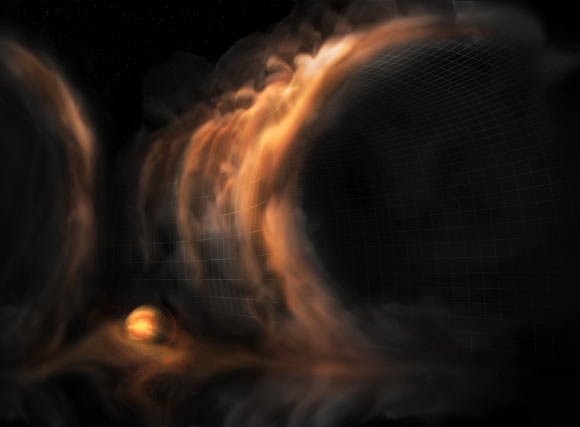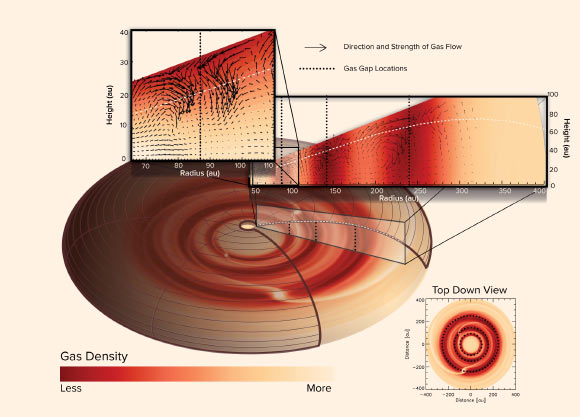ALMA Finds Gas Waterfalls in Planet-Forming Disk around HD 163296 | Astronomy – Sci-News.com
At three locations in the protoplanetary disk around HD 163296, a young star located approximately 400 light-years away in the constellation Sagittarius, gas is flowing like a waterfall into gaps that are most likely caused by planets in formation.

An artist’s impression of gas flowing like a waterfall into a protoplanetary disk gap, which is most likely caused by an infant planet. Image credit: NRAO / AUI / NSF / S. Dagnello.
Protoplanetary disks are the gas- and dust-filled planet factories that encircle young stars. Most of their mass is gas, of which carbon monoxide (CO) is the brightest component.
Last year, two teams of astronomers demonstrated a new planet-hunting technique using this gas.
Using the Atacama Large Millimeter/submillimeter Array (ALMA), they measured the velocity of CO rotating in the disk around HD 163296. Localized disturbances in the movements of the gas revealed three planet-like patterns in the disk.
In the new study, University of Michigan’s Dr. Richard Teague and colleagues used high-resolution ALMA data from the Disk Substructures at High Angular Resolution Project (DSHARP) to study the gas’s velocity in more detail.
“With the high fidelity data from this program, we were able to measure the gas’s velocity in three directions instead of just one,” Dr. Teague said.
“For the first time, we measured the motion of the gas rotating around the star, towards or away from the star, and up- or downwards in the disk.”
The astronomers saw the gas moving from the upper layers towards the middle of the disk at three different locations. This is the best evidence to date that there are indeed planets being formed around HD 163296.
But astronomers cannot say with one hundred percent certainty that the gas flows are caused by planets. For example, the star’s magnetic field could also cause disturbances in the gas.

A computer simulation showed that the patterns of gas flows are unique and are most likely caused by planets in three locations in the disk around HD 163296. Planets in orbit around the star push the gas and dust aside, opening gaps. The gas above the gaps collapses into it like a waterfall, causing a rotational flow of gas in the disk. Image credit: ALMA / ESO / NAOJ / NRAO / J. Bae / AUI / NSF / S. Dagnello.
“Right now, only a direct observation of the planets could rule out the other options,” said Dr. Jaehan Bae, an astronomer at the Carnegie Institution for Science.
“But the patterns of these gas flows are unique and it is very likely that they can only be caused by planets.”
The location of the three predicted planets in this study correspond to the results from last year: they are likely located at 87, 140 and 237 AU.
The closest planet to HD 163296 is calculated to be half the mass of Jupiter, the middle planet is Jupiter-mass, and the farthest planet is twice as massive as Jupiter.
“Planets form in the middle layer of the disk, the so-called midplane. This is a cold place, shielded from radiation from the star,” Dr. Teague said.
“We think that the gaps caused by planets bring in warmer gas from the more chemically active outer layers of the disk, and that this gas will form the atmosphere of the planet.”
Dr. Teague and co-authors did not expect that they would be able to see this phenomenon.
“The disk around HD 163296 is the brightest and biggest disk we can see with ALMA,” Dr. Teague said.
“But it was a big surprise to actually see these gas flows so clearly. The disks appear to be much more dynamic than we thought.”
“This gives us a much more complete picture of planet formation than we ever dreamed,” said Dr. Ted Bergin, a researcher at the University of Michigan.
“By characterizing these flows we can determine how planets like Jupiter are born and characterize their chemical composition at birth. We might be able to use this to trace the birth location of these planets, as they can move during formation.”
The results are published in the journal Nature.
_____
Richard Teague et al. 2019. Meridional flows in the disk around a young star. Nature 574: 378-381; doi: 10.1038/s41586-019-1642-0





